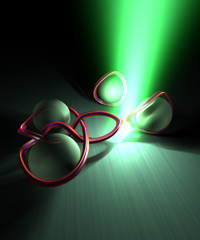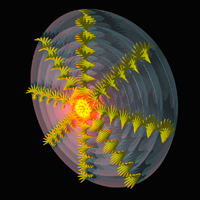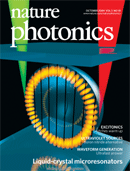Welcome to the Soft Matter Laboratory

- Science 2011
- Perspective by Randall Kamien
- Further reading

A Bragg onion laser based on cholesteric liquid-crystal microdroplets was developed in our laboratory. This is the first practical single mode microlaser that emitts light isotropically in 3D.
- Optics Express 2010
- Press release
- Further reading
- VIDEO of lasing

(Nature Photonics 2009)
Our current research is focused on:
• Self-assembly in nematic colloids. We use optical tweezers to manipulate colloidal particles in nematic liquid crystals and we measure the forces and potential of colloidal interactions, mediated by the nematic. The aim of our research is to understand how and why small particles assemble in regular 2D patterns, which may lead to interesting photonic applications in the future, such as 3D photonic crystals and metamaterials, self-assembled from solid particles in nematics. (PRL 2009, PRL 2008, PRL 2007, PRL 2007, Science 2006)
• Liquid crystal optical microresonators. We study the optical properties of small droplets of a nematic liquid crystal embedded in a polymer matrix. When the refractive index of the matrix is smaller compared to the droplet, Whispering Gallery Modes can be supported inside LC microdroplets. This is light, circulating in a cavity after bouncing from the walls due to total internal reflection. The WGM spectrum can be tuned by external electric field, which opens many interesting applications as add/drop optical switches, sensors, tunable lasers, etc. (Nature Photonics 2009)
• Metamaterials from nematic colloids. Nematic hierarchical colloidal superstructures are promising candidates for spontaneous formation of split-ring-resonators (SRR), known to generate negative magnetic response at the resonant frequency. We are exploring the physics and, in particular, the optics of colloidal superstructures in the nematic liquid crystals with applications to electric-field-controlled metamaterials. (PRE 2008)
Read more about history of the lab...
Our laboratory is collaborating with
Theory and simulation group
Recent Publications
- Reconfigurable knots and links in chiral nematic colloids, Science- Liquid crystals: Maximizing memory, Nature Materials
- 3D microlasers from self-assembled cholesteric liquid-crystal microdroplets, Opt. Express
- Pinning of adsorbed cobalt atoms by defects embedded in copper (111) surface, Phys. rev. lett.
- Vortexlike topological defects in nematic colloids, Phys. rev. lett.
- Electrically tunable liquid crystal optical microresonators, Nature Photonics
All Publications


